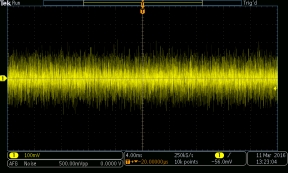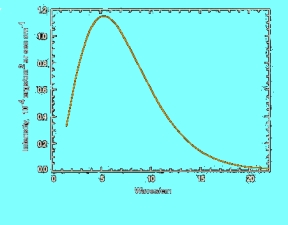In an audio or video receiver or in any type of measuring instrument, noise may be defined as any signal other than the one of interest. In the display of an auto-ranging oscilloscope, it is manifest as an irregular horizontal trace not far above the X-axis.
There are many sources of noise, both human-made and arising in nature. Generally, noise is unwanted because it imposes a lower-amplitude limit to energy that may be perceived or measured. In electronics, thermal noise is theoretically ubiquitous, although techniques may be used to reduce it to close to zero.
Thermal noise, also known as Johnson-Nyquist noise, results from the motion of electrons and other charge carriers banging around inside the conductors and devices in electronic equipment, colliding with each other and striking the inner walls of the medium in which they are confined. As the applied voltage increases, the particles become more agitated and the thermal noise increases in amplitude.

This Tektronix MDO3104 oscilloscope has a built-in Arbitrary Frequency Generator. Among the many available waveforms is this simulated noise signal.
When voltage is applied across a conducting medium (resistive load), it causes current fluctuations, even if the voltage is filtered dc. This translates to particle motion, and it is equally applicable when we are looking at ions in an electrolyte.
In digital photography, thermal noise afflicts the sensor, and shows up as small specks in the electronic image. In astrophotography, it is difficult to differentiate this spurious information from real stars within the field of view. For this reason, a priority is to reduce thermal noise in the sensor and in connected circuitry. One method, nearly universally used, is to cool the sensor and circuitry. A simple home-brew method for doing this is to place ice in a waterproof plastic bag around the camera.
Charge coupled device (CCD) astronomical cameras are susceptible to read noise, dark current noise and sky background noise. For the duration of a time exposure, unlike read noise, dark current and sky noise are cumulative. Dark current noise can be minimized by cooling the sensor. This thermal noise can be cut in half by each drop of six degrees Celsius applied to the sensor. Cooling can be effective to 40 degrees Celsius below the ambient temperature, reducing dark current by a factor of 1000.
Cooling is used in many other types of electronic equipment to reduce thermal noise. For extraterrestrial communication with satellites and spacecraft, for years transistors have been cooled. This greatly reduces their thermal noise, which becomes more of an issue at microwave frequencies.
A lot of microwave noise is the result of the Big Bang that caused the origin of the universe. The bottom line was found to be that the universe is very rapidly expanding. Recent research indicates that this rate of expansion is accelerating. If, hypothetically, we could reverse time’s arrow and see the process moving backwards, the notion that all the matter in the universe originated at a single point would seem likely. And in fact this hypothesis was supported by abundant observational and theoretical research in the latter half of the twentieth century. At present we have a large amount of detailed knowledge regarding the first second after this still enigmatic event occurred.
From temporal point zero to a certain finite amount of time afterwards, all matter and energy existed as an undifferentiated quantum entity, best thought of as a probability wave.
The history of the universe first became knowable 10-43 seconds after the primeval event that we call the Big Bang. (That is an inconceivably small amount of time, 10 million trillion trillion trillionths of a second.) Prior to that historic benchmark, all four fundamental forces, gravity, electromagnetism and the strong and weak nuclear forces were undifferentiated, and for that reason the state of affairs during that brief interval is probably forever unknowable.
From Big Bang to 10-43 seconds is equivalent to one Planck time. At the end of this very short interval, the universe was a mere 10-35 meters in diameter, a distance known as the Planck length. The temperature was 1,032°C, the Planck temperature.
Abruptly, there were enormous changes, still on a tiny scale. From 10-43 to 10-36 seconds is called the grand unification epoch. Herein the force of gravity diverges from the other fundamental forces, which remain undifferentiated. The first elementary particles emerge.
From 10-36 to 10-32 seconds the universe is in its much-studied inflationary period, also known as cosmic inflation. During this tiny fraction of a second, the rate of expansion of the universe vastly accelerated so its size increased by an astonishing factor of 1,026, becoming the size of a grapefruit. This rapid temporary rise in the rate of expansion was triggered, according to current theory, by separation of the strong nuclear force, all this in a tiny fraction of the first second following the Big Bang.

Measurements of the blackbody spectrum obtained by NASA’s Cosmic Background Explorer (COBE) satellite show cosmic radiation peaks at about 150 GHz.
Cosmic microwave background (CMB), or cosmic radiation noise, is the thermal radiation left over from the time of recombination in Big Bang cosmology.Though it lies mainly in the microwave band, it is the oldest light in the universe, dating to the epoch of recombination. As the universe expanded, both the plasma and the radiation filling it grew cooler. When the universe cooled enough, protons and electrons combined to form neutral hydrogen atoms.
The time period when neutral atoms first formed is called the recombination epoch. Shortly afterwards, photons started to travel freely through space rather than constantly being scattered by electrons and protons in plasma. This period is referred to as photon decoupling. The photons existing at the time of photon decoupling have been propagating ever since. But the expansion of space causes their wavelength to increase over time. In this way, microwave cosmic noise is actually what were once photons created at the beginning of the universe.
The post Where does the noise floor come from? appeared first on Test & Measurement Tips.

